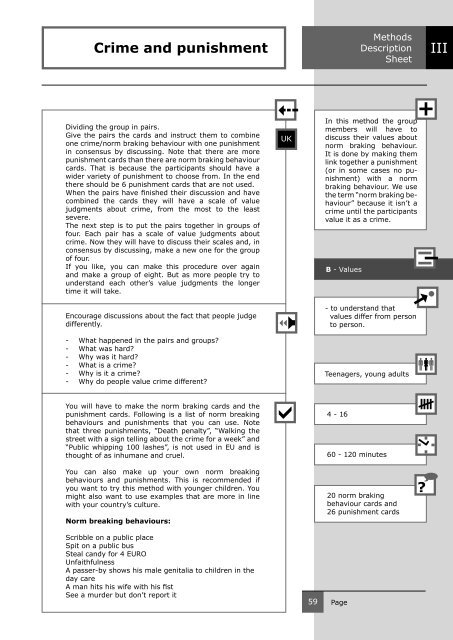Who are you? - Emergency Brake
Who are you? - Emergency Brake
Who are you? - Emergency Brake
You also want an ePaper? Increase the reach of your titles
YUMPU automatically turns print PDFs into web optimized ePapers that Google loves.
Crime and punishment<br />
Dividing the group in pairs.<br />
Give the pairs the cards and instruct them to combine<br />
one crime/norm braking behaviour with one punishment<br />
in consensus by discussing. Note that there <strong>are</strong> more<br />
punishment cards than there <strong>are</strong> norm braking behaviour<br />
cards. That is because the participants should have a<br />
wider variety of punishment to choose from. In the end<br />
there should be 6 punishment cards that <strong>are</strong> not used.<br />
When the pairs have finished their discussion and have<br />
combined the cards they will have a scale of value<br />
judgments about crime, from the most to the least<br />
severe.<br />
The next step is to put the pairs together in groups of<br />
four. Each pair has a scale of value judgments about<br />
crime. Now they will have to discuss their scales and, in<br />
consensus by discussing, make a new one for the group<br />
of four.<br />
If <strong>you</strong> like, <strong>you</strong> can make this procedure over again<br />
and make a group of eight. But as more people try to<br />
understand each other’s value judgments the longer<br />
time it will take.<br />
Encourage discussions about the fact that people judge<br />
differently.<br />
- What happened in the pairs and groups?<br />
- What was hard?<br />
- Why was it hard?<br />
- What is a crime?<br />
- Why is it a crime?<br />
- Why do people value crime different?<br />
You will have to make the norm braking cards and the<br />
punishment cards. Following is a list of norm breaking<br />
behaviours and punishments that <strong>you</strong> can use. Note<br />
that three punishments, ”Death penalty”, “Walking the<br />
street with a sign telling about the crime for a week” and<br />
“Public whipping 100 lashes”, is not used in EU and is<br />
thought of as inhumane and cruel.<br />
You can also make up <strong>you</strong>r own norm breaking<br />
behaviours and punishments. This is recommended if<br />
<strong>you</strong> want to try this method with <strong>you</strong>nger children. You<br />
might also want to use examples that <strong>are</strong> more in line<br />
with <strong>you</strong>r country’s culture.<br />
Norm breaking behaviours:<br />
Scribble on a public place<br />
Spit on a public bus<br />
Steal candy for 4 EURO<br />
Unfaithfulness<br />
A passer-by shows his male genitalia to children in the<br />
day c<strong>are</strong><br />
A man hits his wife with his fist<br />
See a murder but don’t report it<br />
UK<br />
59<br />
B - Values<br />
Page<br />
Methods<br />
Description<br />
Sheet<br />
In this method the group<br />
members will have to<br />
discuss their values about<br />
norm braking behaviour.<br />
It is done by making them<br />
link together a punishment<br />
(or in some cases no punishment)<br />
with a norm<br />
braking behaviour. We use<br />
the term “norm braking behaviour”<br />
because it isn’t a<br />
crime until the participants<br />
value it as a crime.<br />
- to understand that<br />
values differ from person<br />
to person.<br />
Teenagers, <strong>you</strong>ng adults<br />
4 - 16<br />
60 - 120 minutes<br />
20 norm braking<br />
behaviour cards and<br />
26 punishment cards<br />
?<br />
III


